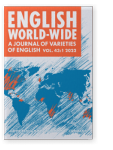Vol. 43:1 (2022) ► pp.66–95
The trappings of order
Linguistic features of Anglophone Caribbean administrative writing
This study builds off of previous research into Caribbean Standard Englishes (which has largely used newspaper genres) by comparing the rates of features found in corpora of Bahamian, Jamaican, British, and American administrative writing, paying particular attention to whether and how the noted formality of Caribbean Standard Englishes manifests itself in administrative writing. The study employs expanded versions of ICE administrative subcorpora for the analysis. Features analyzed include lexis, orthography, as well as different morphosyntactic constructions such as be-passives and modals of obligation and necessity. The study finds that the contemporary British administrative writing corpus contains the most informal lexical choice of the national corpora studied, problematizing a Caribbean folk narrative that associates formality in administrative language and practice with Britishness.
Article outline
- 1.Introduction
- 2.Theoretical background
- 2.1Colonial legacies in the contemporary Anglophone Caribbean
- 2.2Administrative writing
- 2.3Movements towards informality in language
- 2.4Linguistic features indicating formality
- 2.5Previous research on Caribbean Standard Englishes
- 3.Data and methodology
- 4.Results
- 4.1Lexis
- 4.2Orthography
- 4.3Morphosyntax
- 4.3.1 Be-passive constructions
- 4.3.2Contractions
- 4.3.3Modals of obligation and necessity
- 5.Discussion
- 6.Conclusion
- Notes
-
References
